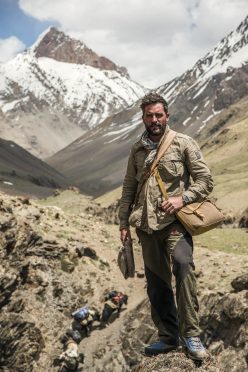Is it still possible to be an explorer in today’s modern, mapped-out world? Adventurer Levison Wood, star of Channel 4’s Walking The Himalayas, says yes
It is true most of the world has already been mapped, but for modern explorer Levison Wood, there are still plenty of discoveries to be made.
The 33-year old writer and photographer is currently captivating TV audiences in a Channel 4 series documenting his attempt to walk the length of the Himalayas. A book about his travels, Walking The Himalayas, has also been published this month.
“Exploration is really about documenting a moment in time,” he says. “Through my writing and photography, I try to show people something more off the beaten track, to challenge stereotypes.”
His reporting style has earned him praise from critics, who find his programmes a refreshing alternative to the dramatic, survival-style shows that proliferate on TV screens.
“For me, the real focus is the journey.”
Next month, Wood will be giving talks at the Outdoor & Adventure Travel show in London. No doubt, given the current political climate, the topic of risk-associated travel will come up.
Having served in Afghanistan as an Officer in the British Parachute Regiment, Wood is no stranger to conflict. After leaving the army, he co-founded the Secret Compass travel company, which offers trips to remote and difficult destinations. His own adventures also often take him to areas with FCO advisories.
“The FCO has a duty of care to uphold, and it’s true certain parts of the world carry a higher risk. But I don’t believe it’s irresponsible to travel to those places. A general air of caution shouldn’t put people off travel, because problems are usually localised.”
The most important thing, he says, is “to do your homework”.
“You need to know what you’re doing and to plan carefully. I prefer to make decisions for myself.”
One country that Wood urges people to visit is Nepal, a place he passed through on his 1,700-mile journey from Afghanistan to the mountain kingdom of Bhutan. Advisories following last year’s earthquake have been lifted, but tourists are still hesitant to return.
“Go there. It’s fine,” he says. “The Nepalese are desperate for tourists; the last thing they want is for people to stay away.”
Along with writing, Wood also uses photography to document his travels. Images taken during his four-month journey tracing the route of the Nile were recently exhibited in London. So what tips does he have for budding travel photographers?
“Exercise a degree of sensitivity,” he advises. “Don’t go in there with cameras blazing. Chat to people and get to know the place first.”
:: Levison Wood will be speaking at the Outdoor Adventure & Travel Show at London ExCeL, which takes place from February 11-14, 2016. Visit www.telegraphoutdoorshow.co.uk
